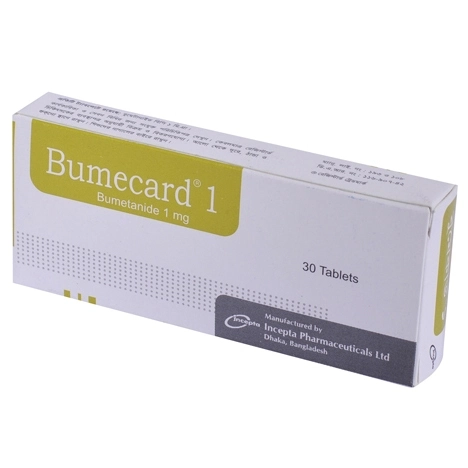Unit Price:
৳ 5.00
(3 x 10: ৳ 150.00)
Strip Price:
৳ 50.00
Also available as:
Indications
Bumecard is indicated for the treatment of edema associated with congestive heart failure, hepatic and renal disease, including the nephrotic syndrome.
Pharmacology
Bumetanide is a loop diuretic with a rapid onset and short duration of action. Pharmacological and clinical studies have shown that 1 mg Bumetanide has a diuretic potency equivalent to approximately 40 mg furosemide. The major site of Bumetanide action is the ascending limb of the loop of Henle.
Bumetanide inhibits sodium reabsorption in the ascending limb of the loop of Henle. Reabsorption of chloride in the ascending limb is also blocked by Bumetanide.
Bumetanide may have an additional action in the proximal tubule. Since phosphate reabsorption takes place largely in the proximal tubule, phosphaturia during Bumetanide induced diuresis is indicative of this additional action. This proximal tubular activity does not seem to be related to an inhibition of carbonic anhydrase. Bumetanide does not appear to have a noticeable action on the distal tubule.
Bumetanide inhibits sodium reabsorption in the ascending limb of the loop of Henle. Reabsorption of chloride in the ascending limb is also blocked by Bumetanide.
Bumetanide may have an additional action in the proximal tubule. Since phosphate reabsorption takes place largely in the proximal tubule, phosphaturia during Bumetanide induced diuresis is indicative of this additional action. This proximal tubular activity does not seem to be related to an inhibition of carbonic anhydrase. Bumetanide does not appear to have a noticeable action on the distal tubule.
Dosage & Administration
Oral: 1 mg in the morning, repeated after 6-8 hours if necessary, In severe cases, 5 mg daily increased by 5 mg every 12-24 hours according to response. Elderly, 500 micrograms daily may be sufficient.
By IV Injection: 1-2 mg, repeated after 20 minutes if necessary. Elderly, 500 micrograms (1 ml of Bumecard) daily may be sufficient.
By IV Infusion: 2-5 mg over 30-60 minutes.Elderly, 500 micrograms (1 ml of Bumecard) daily may be sufficient.
By IM Injection: 1 mg initially then adjusted according to response, Elderly 500 micrograms (1 ml of Bumecard) daily may be sufficient.
Paediatric use: Safety and effectiveness in paediatric patients below the age of 18 have not been established.
By IV Injection: 1-2 mg, repeated after 20 minutes if necessary. Elderly, 500 micrograms (1 ml of Bumecard) daily may be sufficient.
By IV Infusion: 2-5 mg over 30-60 minutes.Elderly, 500 micrograms (1 ml of Bumecard) daily may be sufficient.
By IM Injection: 1 mg initially then adjusted according to response, Elderly 500 micrograms (1 ml of Bumecard) daily may be sufficient.
Paediatric use: Safety and effectiveness in paediatric patients below the age of 18 have not been established.
Interaction
Lithium: Lithium should generally not be given with diuretics because they reduce its renal clearance and add a high risk of lithium toxicity.
Probenecid: should not be administered concurrently with Bumecard.
Indomethacin: Concurrent therapy with Bumecard is not recommended.
Antihypertensives: Bumecard may potentiate the effect of various antihypertensive drugs, necessitating a reduction in the dosage of these drugs.
Digoxin: Interaction studies in humans have shown no effect on digoxin blood levels.
Anticoagulants: Interaction studies in humans have shown Bumecard to have no effect on warfarin metabolism.
Probenecid: should not be administered concurrently with Bumecard.
Indomethacin: Concurrent therapy with Bumecard is not recommended.
Antihypertensives: Bumecard may potentiate the effect of various antihypertensive drugs, necessitating a reduction in the dosage of these drugs.
Digoxin: Interaction studies in humans have shown no effect on digoxin blood levels.
Anticoagulants: Interaction studies in humans have shown Bumecard to have no effect on warfarin metabolism.
Contraindications
Loop diuretics should be avoided in severe hypokalaemia, severe hyponatraemia, anuria, comatose and precomatose states associated with liver cirrhosis and in renal failure.
Side Effects
Muscle cramps (1.1%), dizziness (1.1%), hypotension (0.8%), headache (0.6%), nausea (0.6%) Others (ECG changes (0.4 %), musculoskeletal pain (0.2 %), Abdominal pain (0.2 %), renal failure (0.1%), thrombocytopenia (0.2%) etc.
Pregnancy & Lactation
Pregnancy Category C. There are no adequate and well controlled studies in pregnant woman. It is not known wheather this drug is excreted in human milk.
Precautions & Warnings
Serum potassium should be measured periodically and potassium supplements or potassium sparing diuretics added if necessary.
Use in Special Populations
Paediatric use: Safety and effectiveness in paediatric patients below the age of 18 have not been established.
Overdose Effects
Overdosage can lead to acute profound water loss, volume and electrolyte depletion, dehydration, reduction of blood volume and circulatory collapse with a possibility of vascular thrombosis and embolism. Treatment consists of replacement of fluid and electrolyte losses by careful monitoring of the urine and electrolyte output and serum electrolyte levels.
Therapeutic Class
Loop diuretics
Storage Conditions
Keep below 30°C temperature, away from light & moisture. Keep out of the reach of children.


